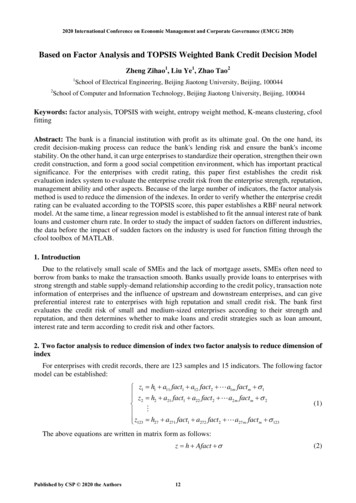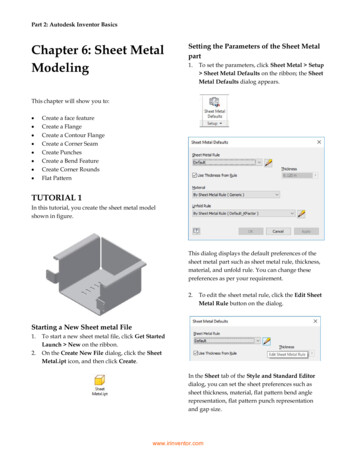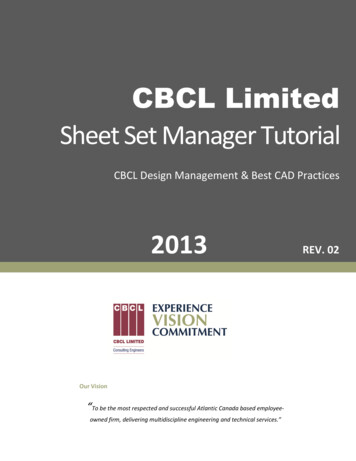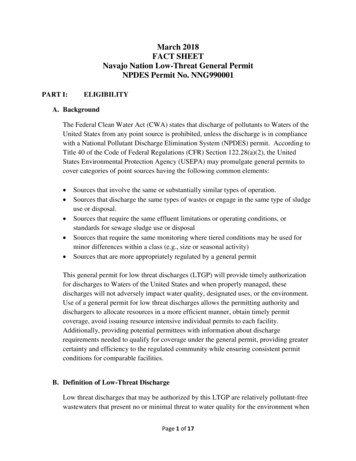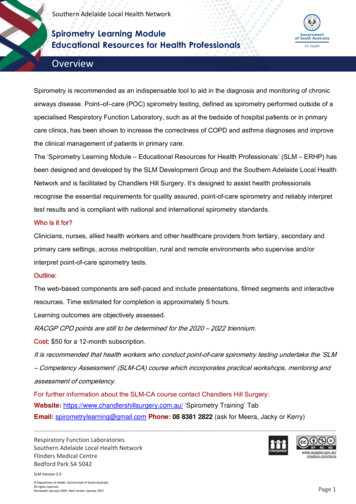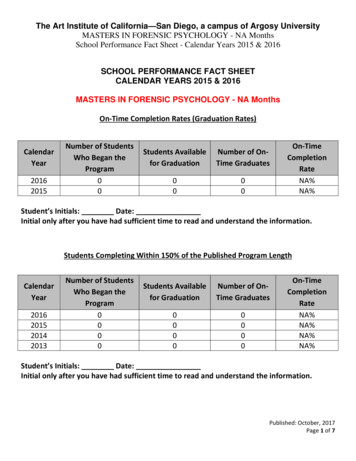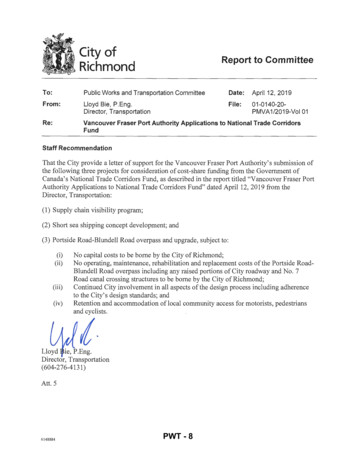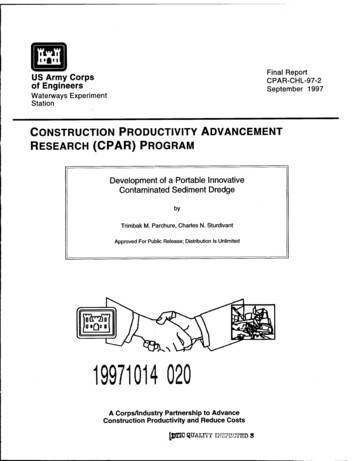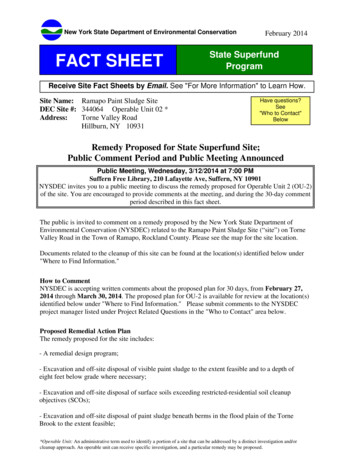
Transcription
Puerto Rico Aqueduct and Sewer AuthorityLares WWTPNPDES NO. PR0025879United States Environmental Protection AgencyRegion 2Caribbean Environmental Protection DivisionCity View Plaza II–Suite 7000, #48 Rd. 165 km 1.2Guaynabo, Puerto Rico 00968-8069FACT SHEETDRAFT NATIONAL POLLUTANT DISCHARGE ELIMINATION SYSTEMLares WWTPPERMIT No. PR0025879This Fact Sheet sets forth the principle facts and technical rationale that serve as the legal basis for therequirements of the accompanying draft permit. The draft permit has been prepared in accordance with CleanWater Act (CWA) section 402 and its implementing regulations at Title 40 of the Code of Federal Regulations(CFR), Parts 122 through 124, and the Water Quality Certificate (WQC) issued by the Puerto Rico EnvironmentalQuality Board (EQB) pursuant to CWA section 401 requirements.Pursuant to 40 CFR 124.53, the Commonwealth of Puerto Rico must either grant a certification pursuant to CWAsection 401 or waive this certification before the U.S. Environmental Protection Agency (EPA) may issue a finalpermit. On February 8, 2016, EQB provided in the WQC that the allowed discharge will not cause violations to theapplicable water quality standards at the receiving water body if the limitations and monitoring requirements in theWQC are met. In accordance with CWA section 401, EPA has incorporated the conditions of the interim WQCinto the draft permit. Any changes to the interim WQC will be incorporated into the final issuance of the permit.The WQC conditions are discussed in this Fact Sheet and are no less stringent than allowed by federalrequirements. Additional requirements might apply to comply with other sections of the CWA. Review and appealsof limitations and conditions attributable to the WQC were made through the applicable procedures of theCommonwealth of Puerto Rico and not through EPA procedures.PART I. BACKGROUNDA. Permittee and Facility DescriptionThe Puerto Rico Aqueduct and Sewer Authority (PRASA) (referred to throughout as the Permittee) has applied forrenewal on its Lares WWTP National Pollutant Discharge Elimination System (NPDES) permit. The Permittee isdischarging pursuant to NPDES Permit No. PR0025879. The Permittee submitted Application Form 1, and 2Adated December 13, 2013, and applied for an NPDES permit to discharge treated wastewater from LaresWWTP, Lares, called the facility. The facility is classified as a major discharger by EPA in accordance with theEPA rating criteria.The Permittee owns and operates wastewater treatment plant which provides secondary treatment. Attachment Aof this Fact Sheet provides a map of the area around the facility and a flow schematic of the facility.The treatment system consists of the following:The Lares WWTP is a publicly owned treatment work (POTW) that treats sanitary wastewater throughsecondary treatment of the domestic sewage from the Municipality of Lares. It has a capacity of 1.206 MGD(design flow rate), and provides secondary treatment and discharge its effluent to the Guajataca River.Sanitary wastewater is processed through the following units, see Attachment A (Schematic Flow Diagram formore details:1.Bar Screen2.Grit Chamber3.Comminutor4.Splitter Box No. 15.Primary Clarifiers6.Splitter Box No.27.Biofilters8.Splitter Box No. 39. Final Clarifiers10.Pumping Sta. No.211.Digesters12.Sludge Drying Beds13.Pumping Sta. No. 314.Chlorine Contact Chamber15.Dechlorination System16.Parshall FlumeSludge is thickened, dewatered and disposed in a landfill.NPDES Fact Sheet1
Puerto Rico Aqueduct and Sewer AuthorityLares WWTPNPDES NO. PR0025879Summary of Permittee and Facility InformationPermitteePuerto Rico Aqueduct and Sewer Authority (PRASA)Mrs. Irma Lopez, Executive DirectorFacility contact, title, phoneCompliance and Quality Control(787) 620-2270Puerto Rico Aqueduct and Sewer AuthorityPermittee (mailing) addressP.O. Box 7066Barrio Obrero StationSanturce, Puerto Rico 00916-7066Facility (location) addressRoad 452, Km 0.9, Guajataca WardLares, P.R. 00669Type of facilityPublically-owned Treatment WorksPretreatment programYesFacility daily average flow0.765 MGD (in million gallons per day)Facility design flow1.206 MGD (in million gallons per day)Facility classificationMajorB. Discharge Points and Receiving Water InformationWastewater is discharged from Outfall 001 to the Guajataca River, a water of the United States.The draft permit authorizes the discharge from the following discharge point(s):Outfall001Effluent descriptionSecondary municipalwastewater.Outfall latitude18 , 18’′, 28″ NOutfall longitude66 , 52′, 49″ WReceiving water name andclassificationGuajataca River, Class SD watersAs indicated in the Puerto Rico Water Quality Standards (PRWQS) Regulations, the designated uses for ClassSD receiving waters include: Primary and secondary recreation; and Propagation and preservation of desirable species, including threatened and endangered species.CWA section 303(d) requires the Commonwealth of Puerto Rico to develop a list of impaired waters, establishpriority rankings for waters on the list, and develop TMDLs for those waters. The receiving water has not beendetermined to have water quality impairments for one or more of the designated uses as determined by section303(d) of the CWA.C. Compliance Orders/Consent DecreesThe Permittee has a Consent Decree with the Agency (civil action no 06-16-24 (sec)) in which the facility isincluded. This consent decree does not affect this permit action.E. Summary of Basis for Effluent Limitations and Permit Conditions - GeneralThe effluent limitations and permit conditions in the permit have been developed to ensure compliance with thefollowing, as applicable: Clean Water Act section 401 certification requirements;NPDES regulations (40 CFR Part 122); andPRWQS (March 2014).NPDES Fact Sheet2
Puerto Rico Aqueduct and Sewer AuthorityLares WWTPNPDES NO. PR0025879PART II. RATIONALE FOR EFFLUENT LIMITATIONS AND MONITORING REQUIREMENTSCWA section 301(b) and 40 CFR 122.44(d) require that permits include limitations more stringent than applicabletechnology-based requirements where necessary to achieve applicable water quality standards. In addition,40 CFR 122.44(d)(1)(i) requires that permits include effluent limitations for all pollutants that are or may bedischarged at levels that cause, have the reasonable potential to cause, or contribute to an exceedance of awater quality criterion, including a narrative criterion. The process for determining reasonable potential andcalculating water quality-based effluent limits (WQBELs) is intended to protect the designated uses of thereceiving water, and achieve applicable water quality criteria. Where reasonable potential has been establishedfor a pollutant, but there is no numeric criterion for the pollutant, WQBELs must be established using (1) EPAcriteria guidance under CWA section 304(a), supplemented where necessary by other relevant information; (2) anindicator parameter for the pollutant of concern; or (3) a calculated numeric water quality criterion, such as aproposed state criterion or policy interpreting the state’s narrative criterion, supplemented with other relevantinformation, as provided in 40 CFR 122.44(d)(1)(vi).The effluent limitations and permit conditions in the permit have been developed to ensure compliance with allfederal and state regulations, including PRWQS. The basis for each limitation or condition is discussed below.A. Effluent LimitationsThe permit establishes both Technology-based Effluent Limitations (TBELs) and WQBELs for severalpollutants and the basis for these limitations are discussed below.1. Flow: An effluent limitation for flow has been established in the permit for 1.206 MGD as a DailyMaximum. Monitoring conditions are applied pursuant to 40 CFR 122.21(j)(4)(ii) and EQB’s Water QualityCertificate. The frequency monitoring for flow shall be continuous with a flow meter.2. 5-Day Biochemical Oxygen Demand (BOD5): The effluent concentration and percent removallimitations are based on technology-based secondary treatment standards for publicly owned treatmentworks (POTWs) specified in 40 CFR 133.102(a). The permit also requires influent monitoring andreporting in accordance with 40 CFR 122.44(i) to meet the requirement of the percent removal limitation(see section C.1.—Monitoring Requirements— of this Part).3. Total Suspended Solids (TSS): The effluent concentration and percent removal limitations are based ontechnology-based secondary treatment standards for POTWs specified in 40 CFR 133.102(b). The permitalso requires influent monitoring and reporting in accordance with 40 CFR 122.44(i) to meet therequirement of the percent removal limitation (see section C.1.—Monitoring Requirements— of this FactSheet).4. pH: The effluent limitation for pH is based on technology-based secondary treatment standards forPOTWs specified for Class SD D 2.c. of PRWQS, and the WQC. In no case the pH will lie outside of 6.0to 9.0, standard pH units, except when it is altered by natural causes.5. Temperature: The effluent limitation for temperature is based on the water quality criterion for all watersin Puerto Rico as specified in Rule 1303.1 D of PRWQS, and the WQC.6. Fecal Coliforms: The discharge consists of domestic sewage that is a source of pathogens. To ensurethat the recreational use of the water body is met, effluent limitations for fecal coliform are established inthe permit and are based on the water quality criterion for Class SD waters as specified in Rule 1303.2 D.2.b of PRWQS, and the WQC. Consistent with the expression of the water quality criteria for fecalcoliform, EPA establishes a monitoring frequency of 5 grab samples per month to calculate a geometricmean and to monitor and report the single sample result of each of the 5 samples to comply with theeffluent limitation of no more than 20 percent of the single samples must be above the single-samplemaximum of 400 colonies per 100 mL.7. Dissolved Oxygen (DO): The effluent limitation is based on the water quality criterion for Class SDwaters as specified in Rule 1303.2 D.2.a of PRWQS, and the WQC.8. Whole Effluent Toxicity (WET): The permit establishes a requirement for the Permittee to conductaccelerated testing and develop a Toxicity Reduction Evaluation (TRE) Workplan as Special Conditions.These requirements are necessary to ensure that the Permittee has a process for addressing effluenttoxicity if toxicity is observed.NPDES Fact Sheet3
Puerto Rico Aqueduct and Sewer AuthorityLares WWTPNPDES NO. PR00258799. Color: The effluent limitation is based on the water quality criterion for Class SD waters as specified inRule 1303.2.D 2.d of PRWQS, and the WQC.10. Cadmium, Lead, Mercury, Sulfide (undissociated H2S) and Free Cyanide: The effluent limitations isbased on water quality criteria established in PRWQS Rule 1303.1.1.1 of PRWQS and the WQC.11. Turbidity: The effluent limitation is based on the water quality criterion for Class SD waters as specifiedin Rule 1303.2 D.2.e of PRWQS, and the WQC.12. Taste and Other Producing Substances: The effluent limitation is based on the water quality criterionfor Class SD waters as specified in Rule 1303.2.D2.g of PRWQS, and the WQC.13. Surfactants: The effluent limitation is based on the water quality criterion for Class SD waters asspecified in Rule 1303.2 D.2.i of PRWQS, and the WQC.14. Total Dissolved Solids: The effluent limitation is based on the water quality criterion for Class SDwaters as specified in Rule 1303.2 D.2.f of PRWQS, and the WQC.15. Total Phosphorus: The effluent limitation is based on the water quality criterion for Class SD waters asspecified in Rule 1303.2 D.2.h of PRWQS, and the WQC.16. Total Ammonia: The effluent limitation is based on the water quality criterion for Class SD waters asspecified in Rule 1303.2 D.2.m of PRWQS, and the WQC.17. Total Nitrogen (NO2, NO3, TKN): The effluent limitation is based on the water quality criterion for ClassSD waters as specified in Rule 1303.2 D.2.h of PRWQS, and the WQC.18. Oil and Grease: The effluent limitation is based on the water quality standards as specified in Rule1303.1.H of PRWQS, and the WQC.19. Suspended. Colloidal or Settleable Solids: The effluent limitation is based on the water qualitystandards as specified in Rule 1303.1.E of PRWQS, and the WQC.20. Solids and Other Matters: The effluent limitation is based on the water quality standards as specified inRule 1303.1.A of PRWQS, and the WQC.21. Total Residual Chlorine, Mercury, and Nitrate plus Nitrite: The effluent limitation is based on the waterquality standards as specified in Rule 1303.1.I.1 of PRWQS, and the WQC.B. Effluent Limitations Summary Table1. Outfall Number 001Effluent limitationsAveragingperiodHighestReportedValue (1)ExistinglimitsAverage monthly3630.0Average weekly4845.0%Daily minimum75 (*)85n/a85TBELColorPt-CoDaily Maximum2015n/a22WQBELCadmiumµg/LDaily Maximum0.280.22n/a0.25WBBEL6.02 (*) 3.5n/a 3.5WQBEL200 col / 100mLn/a225200 col / 100mLWQBELParameterBOD5BOD5 percent removalDissolved OxygenUnitsmg/Lmg/LDaily MaximumDaily maximumFecal Coliformcol/100 MGDDaily maximum1.21.206n/a1.206WQBELLeadµg/LDaily maximum0.2Monitorn/a2.8WQBELMercuryµg/LDaily maximum0.0150.05n/a0.05WQBELNPDES Fact Sheet4
Puerto Rico Aqueduct and Sewer AuthorityLares WWTPNPDES NO. PR0025879Effluent ortedValue ,700Daily maximumBasisWQBELTotal Nitrogen (NO2, NO3,TKN)µg/LpHSUDaily maximum8.146.0-9.0n/a6.0-9.0WQBELResidual Chlorinemg/LDaily maximum0.590.5n/a7.5 µg/LWQBELSulfide (undissociated H2S)µg/LDaily maximum3.52n/a3WQBELSurfactantsµg/LDaily maximum1,007183n/a183WQBEL CDaily maximum28.532.2n/a32.2WQBELTotal Ammoniamg/LDaily maximum22.77.3n/aMonitorWQBEL5,34710,000 col /100 mLWQBELcol/100 mL10,000 col /100 mLn/aTotal Coliforms1.981.68n/a240WQBELAverage monthly1830.0n/a30.0Average weekly4845.0%Daily minimum84 (*)85n/a85TBELNTUDaily maximum1450n/a50WQBELTemperatureDaily maximumTotal Phosphorusµg/LTSSmg/LTSS percent removalTurbidityDaily maximum45.0TBELNotes, Footnotes and AbbreviationsNote: Dashes (--) indicate there are no effluent data, no limitations, or no monitoring requirements for this parameter.(1) Wastewater data from DMRs dated December 31, 2013 to December 31, 2015.(*) Minimum reported value2. Outfall 001 Narrative Limitationsa.b.c.d.e.f.The waters of Puerto Rico shall not contain any substance, attributable to the discharge at suchconcentration which, either alone or as result of synergistic effects with other substances, is toxic orproduces undesirable physiological responses in humans, fish, or other fauna or flora.The waters of Puerto Rico shall be substantially free from floating non petroleum oils and greases as wellas petroleum derived oils and greases.The waters of Puerto Rico shall not contain floating debris, scum, or other floating materials attributable todischarges in amounts sufficient to be unsightly or deleterious to the existing or designated uses of thewater body.Solids from wastewater sources shall not cause deposition in or be deleterious to the existing ordesignated uses of the waters.Taste and odor-producing substances shall not be present in amounts that will interfere with primarycontact recreation, or will render any undesirable taste or odor to edible aquatic life.No toxic substances shall be discharged, in toxic concentrations, other than those allowed as specified inthe NPDES permit, Those toxic substances included in the permit renewal application, but not regulatedby the NPDES permit, shall not exceed the concentrations specified in the applicable regulatorylimitations.C. Monitoring RequirementsNPDES regulations at 40 CFR 122.48 require that all permits specify requirements for recording and reportingmonitoring results. The Part III of the Permit establishes monitoring and reporting requirements to implementfederal and state requirements. The following provides the rationale for the monitoring and reporting requirementsfor this facility.NPDES Fact Sheet5
Puerto Rico Aqueduct and Sewer AuthorityLares WWTPNPDES NO. PR00258791. Influent Monitoring RequirementsTo calculate percent removal values, influent monitoring is required for BOD5 and TSS in accordance with40 CFR 133.102. Influent monitoring must be conducted before any treatment, other than de-gritting, andbefore any addition of any internal waste stream.2. Effluent Monitoring RequirementsEffluent monitoring frequency and sample type have been established in accordance with therequirements of 40 CFR 122.44(i) and recommendations in EPA’s TSD. Consistent with 40 CFR Part 136monitoring data for toxic metals must be expressed as total recoverable metal. Effluent monitoring andanalyses shall be conducted in accordance with EPA test procedures approved under 40 CFR Part 136,Guidelines Establishing Test Procedures for the Analysis of Pollutants Under the Clean Water Act, asamended. For situations where there may be interference, refer to Solutions to Analytical ChemistryProblems with Clean Water Act Methods (EPA 821-R-07-002).A licensed chemist authorized to practicethe profession in Puerto Rico shall certify all chemical analyses. All bacteriological tests shall be certifiedby a microbiologist or licensed medical technologist authorized to practice the profession in Puerto Rico.The sampling point for Outfall 001 shall be located immediately after the primary flow measuring device ofthe effluent of the treatment system.D. Compliance with Federal Anti-Backsliding Requirements and Puerto Rico’s Anti-Degradation PolicyFederal regulations at 40 CFR 131.12 require that state water quality standards include an anti-degradation policyconsistent with the federal policy. The discharge is consistent with the anti-degradation provision of 40 CFR131.12, 72 Federal Register 238 (December 12, 2007, pages 70517-70526) and EQB’s Anti-Degradation PolicyImplementation Procedure in Attachment A of PRWQS. In addition, CWA sections 402(o)(2) and 303(d)(4) andfederal regulations at 40 CFR 122.44(l) prohibit backsliding in NPDES permits. Further, the Region 2Antibacksliding Policy provides guidance regarding relaxation of effluent limitations based on water quality forPuerto Rico NPDES permits. These anti-backsliding provisions require effluent limitations in a reissued permit tobe as stringent as those in the previous permit with some exceptions where limitations may be relaxed. The effluent limitations in the permit are at least as stringent as the effluent limitations in the existingpermit, with the exception of effluent limitations for BOD5, Color, Mercury, Sulfide (undissociatedH2S),Surfactants as MBAS, Total Ammonia (NH3), Total Phosphorus, Total Suspended Solids,and Turbidity. The effluent limitations for these pollutants are less stringent that those in the existingpermit. This relaxation of effluent limitations is consistent with the anti-backsliding requirements ofCWA section 401(o), 40 CFR 122.44(l), EPA Region 2’s Anti-backsliding Policy dated August 10,1993, and Puerto Rico’s Anti-Degradation Policy Implementation Procedure established in PRWQS.CWA Sec. 402(o)(2)(B)(i) allows backsliding if information is available which was not available at thetime of permit issuance and would have justified a less stringent effluent limitation at the time ofpermit issuance. EPA has determined that it is appropriate to relax the effluent limitation for theseparameters without violating anti-backsliding provisions of the CWA, in accordance with section402(o)(2), since one of the exceptions to the provisions has been satisfied; and section 402(o)(3)since it complies with EQB’s WQS which include antidegradation requirements. The EQB WQCconstitutes a determination that the limit is sufficient to assure that the water quality standards are orwill be attained. Existing effluent limitations for 2,4,-6 Trichlorophenol, 2,4- Dichlorophenol, 2,4- Dimethylphenol,2,4- Dinitrophenol, 2-Chlorophenol, 2-Methyl-4,6 -Dinitrophenol, Pentachlorophenol, Arsenic,Fluoride, Nitrate Nitrite (as N), Selenium, and Silver have been removed based on CWA section402(o)(2)(B)(i). CWA section 402(o)(2)(B)(i) authorizes the backsliding of effluent limitations ifinformation is available which was not available at the time of permit issuance that would havejustified the application of a less stringent effluent limitation at the time of permit issuance. Based onreview of effluent data since issuance of the existing permit, the modified discharge does not show areasonable potential for the exceedance of water quality criteria for these parameters.NPDES Fact Sheet6
Puerto Rico Aqueduct and Sewer AuthorityLares WWTPNPDES NO. PR0025879PART III. RATIONALE FOR STANDARD AND SPECIAL CONDITIONSA. Standard ConditionsIn accordance with 40 CFR 122.41, standard conditions that apply to all NPDES permits have been incorporatedby reference in Part IV.A.1 of the permit and expressly in Attachment B of the permit. The Permittee must complywith all standard conditions and with those additional conditions that are applicable to specified categories ofpermits under 40 CFR 122.42 and specified in Part IV.A.2 of the Permit.B. Special ConditionsIn accordance with 40 CFR 122.42 and other regulations cited below, special conditions have been incorporatedinto the permit. This section addresses the justification for special studies, additional monitoring requirements,Best Management Practices, Compliance Schedules, and/or special provisions for POTWs as needed. Thespecial conditions for this facility are as follows:1. Special Conditions from the Water Quality CertificateIn accordance with 40 CFR 124.55, EPA has established Special Conditions from the WQC in the permitthat EQB determined were necessary to meet PRWQS. The Special Conditions established in thissection are only those conditions from the IWQC that have not been established in other parts of thepermit.2. Whole Effluent Toxicity TestingEPA has imposed the quarterly testing requirement to collect data necessary to determine whether thisdischarge has the reasonable potential to cause or contribute to an exceedance of Puerto Rico’s waterquality standards for toxicity, pursuant to water quality based permitting requirements at 40 CFR122.44(d)(1), which requires EPA and delegated states to evaluate each National Pollutant DischargeElimination System (NPDES) permit for the potential to exceed state numeric or narrative water qualitystandards, including those for toxics, and to establish effluent limitations for those facilities with the"reasonable potential" to exceed those standards. These federal regulations require both chemicalspecific limits, based on the state numeric water quality standards or other criteria developed by EPA,and whole effluent toxicity effluent limits.3. Best Management Practices (BMP) PlanIn accordance with 40 CFR 122.2 and 122.44(k), BMPs are schedules of activities, prohibitions ofpractices, maintenance procedures, and other management practices to prevent or reduce the pollution towaters of the United States. The Permittee is required to develop a BMP Plan in Part IV.B.3.a of thepermit to control or abate the discharge of pollutants.4. Compliance SchedulesA compliance schedule has not been authorized for any pollutant or parameter in the permit onthe basis of 40 CFR 122.47.PART IV. COMPLIANCE WITH APPLICABLE PROVISIONS OF OTHER FEDERAL LAWS OREXECUTIVE ORDERSA. Coastal Zone Management Act – Not Applicable.B. Endangered Species ActUnder 40 CFR 122.49(c), EPA is required pursuant to section 7 of the Endangered Species Act (ESA), 16 U.S.C.1531 et seq. and its implementing regulations (50 CFR Part 402) to ensure, in consultation with the NationalMarine Fisheries Service (NMFS) and U.S. Fish and Wildlife Service (USFWS) that the discharge authorized bythe permit is not likely to jeopardize the continued existence of any endangered or threatened species oradversely affect its critical habitat. On April 16, 2009, EPA designated PRASA (a non-Federal representative) toconduct informal consultations or prepare a biological assessment for Section 7 Consultations, according to 50CFR 402.8. In the past, no federally listed endangered or threatened species, or critical habitat, are in the vicinityof the discharge. Therefore, it has been determined that the discharge is not likely to affect species or habitatlisted under the ESA.NPDES Fact Sheet7
Puerto Rico Aqueduct and Sewer AuthorityLares WWTPNPDES NO. PR0025879C. Environmental JusticeEPA has performed an Environmental Justice (EJ) Analysis for the discharge in accordance with Executive Order12898, Federal Actions to Address Environmental Justice in Minority Population and Low-Income Populations,and EPA’s Plan EJ 2014. EJ is the right to a safe, healthy, productive and sustainable environment for all, where“environment” is considered in its totality to include the ecological, physical, social, political, aesthetic andeconomic environments. In the NPDES permitting program, the public participation process provides opportunitiesto address EJ concerns by providing appropriate avenues for public participation, seeking out and facilitatinginvolvement of those potentially affected, and including public notices in more than one language whereappropriate. The facility is in an area characterized as a Community of Concern and therefore is subject to the EJrequirements. EPA is committed to taking all necessary actions to minimize potential adverse effects on thecommunity surrounding Lares WWTP. A detailed discussion of the EJ Analysis will be provided in theAdministrative Record and is available for review upon request.D. Coral Reef Protection - Not Applicable.E. Climate ChangeEPA has considered climate change when developing the conditions of the permit. This is in accordance with thedraft National Water Program 2012 Strategy: Response to Climate Change that identifies ways to address climatechange impacts by NPDES permitting authorities (77 Federal Register 63, April 2, 2012, 19661-19662). Climatechange is expected to affect surface waters in several ways, affecting both human health and ecologicalendpoints. As outlined in the draft National Water Program 2012 Strategy, EPA is committed to protecting surfacewater, drinking water, and ground water quality, and diminishing the risks of climate change to human health andthe environment, through a variety of adaptation and mitigation strategies. These strategies include encouragingcommunities and NPDES permitting authorities to incorporate climate change strategies into their water qualityplanning, encouraging green infrastructure and recommending that water quality authorities consider climatechange impacts when developing water load and load allocations for new TMDLs, identifying and protectingdesignated uses at risk from climate change impacts. The 2010 NPDES Permit Writers’ Manual also identifiesclimate change considerations for establishing low-flow conditions that account for possible climatic changes tostream flow. The conditions established in the permit are consistent with the draft National Water Program 2012Strategy.F. National Historic Preservation Act – Not applicable since this is a renovation.G. Magnuson-Stevens Fishery Conservation and Management Act - Not Applicable.PART V. PUBLIC PARTICIPATIONThe procedures for reaching a final decision on the draft permit are set forth in 40 CFR Part 124 and aredescribed in the public notice for the draft permit, which is published in El Vocero. Included in the public noticeare requirements for the submission of comments by a specified date, procedures for requesting a hearing andthe nature of the hearing, and other procedures for participation in the final agency decision. EPA will considerand respond in writing to all significant comments received during the public comment period in reaching a finaldecision on the draft permit. Requests for information or questions regarding the draft permit should be directed toYasmin T. Laguer-DíazEPA Region 2, Caribbean Environmental Protection DivisionPermit Writer Phone: 787-977-5848Permit Writer Email: laguer.yasmin@epa.govA copy of the draft permit is also available on EPA’s website at www.epa.gov/region02/water/permits.html.NPDES Fact Sheet8
Puerto Rico Aqueduct and Sewer AuthorityLares WWTPNPDES NO. PR0025879ATTACHMENT A — FLOW SCHEMATIC AND FACILITY MAPThe facility map and flow schematic are attached as provided by the discharger in the application.NPDES Fact SheetA-2
Puerto Rico Aqueduct and Sewer AuthorityLares WWTPNPDES Fact SheetNPDES NO. PR0025879A-2
Road 452, Km 0.9, Guajataca Ward Lares, P.R. 00669 Type of facility Publically-owned Treatment Works Pretreatment program Yes Facility daily average flow 0.765 MGD (in million gallons per day) Facility design flow 1.206 MGD (in million gallons per day) Facility classification Major B. Discharge Points and Receiving Water Information


